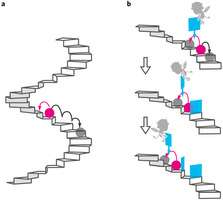November 15, 2010 report
Maxwell's demon demonstration turns information into energy

(PhysOrg.com) -- Scientists in Japan are the first to have succeeded in converting information into free energy in an experiment that verifies the "Maxwell demon" thought experiment devised in 1867.
Maxwell's demon was the invention of Scottish mathematician and theoretical physicist James Clerk Maxwell, who wanted to contradict the second law of thermodynamics (although the name was given to the imaginary being later). This law implies it is not possible to invent a perfect heat engine able to extract heat from a hot reservoir and use all the heat to perform work, because some of the heat must be lost to a cold reservoir.
Maxwell imagined a box containing a gas at a particular temperature (or pressure). In any gas some molecules are hotter (moving faster) and some are cooler (moving slower) than the average. In Maxwell’s thought experiment a partition with a small trapdoor is placed in the box, and the trapdoor is guarded by the imaginary being who, without expending energy, selects which molecules go through to the other side.
The demon, for example, could allow only hotter molecules to remain on the right side, or pass through to the right side, while the cooler than average molecules are allowed into the left side. The end result is that all the hot molecules end up on one side of the box, which is therefore warmer than the other side containing only cool molecules. The demon has essentially converted a mixed gas (disordered state or higher entropy) to separated gases (ordered state or lower entropy), apparently violating the second law of thermodynamics which also says entropy in an isolated system should not decrease.
In Maxwell’s thought experiment the demon creates a temperature difference simply from information about the gas molecule temperatures and without transferring any energy directly to them. The temperature difference in the box could then be used to run a heat engine, with heat flowing from the hot end to the cold end, which also appears to violate the second law of thermodynamics.
In a now-classic 1929 paper on Maxwell’s demon, Hungarian physicist Leo Szilard showed that the thought experiment does not actually violate the laws of physics because the demon must exert some energy in determining whether molecules were hot or cold.
Until now, demonstrating the conversion of information to energy has been elusive, but University of Tokyo physicist Masaki Sano and colleagues have succeeded in demonstrating it in a nano-scale experiment. In a paper published in Nature Physics they describe how they coaxed a Brownian particle to travel upwards on a "spiral-staircase-like" potential energy created by an electric field solely on the basis of information on its location.
The team observed the particle using a high-speed camera. The particle had some thermal energy and moved in random directions. When it was moving up the staircase they allowed it to move freely, but when it moved down the staircase they blocked its movement via a virtual wall created by an electric field. The virtual wall therefore acted like a Maxwell’s demon, only allowing the particle to move in one direction, but not forcing or pushing it.
As the particle traveled up the staircase it gained energy from moving to an area of higher potential, and the team was able to measure precisely how much energy had been converted from information. The experiment did not violate the second law of thermodynamics because energy was consumed in the experiment by the apparatus used, and by the experimenters themselves, who did work in monitoring the particle and adjusting the voltage, but Sano said the experiment does demonstrate that information can be used as a medium for transferring energy.
The results also verified the generalized Jarzynski equation, which was formulated in 1997 by statistical chemist Christopher Jarzynski of the University of Maryland. The equation defines the amount of energy that could theoretically be converted from a unit of information.
More information: Experimental demonstration of information-to-energy conversion and validation of the generalized Jarzynski equality, Nature Physics, Published online: 14 November 2010. doi:10.1038/nphys1821
© 2010 PhysOrg.com



















